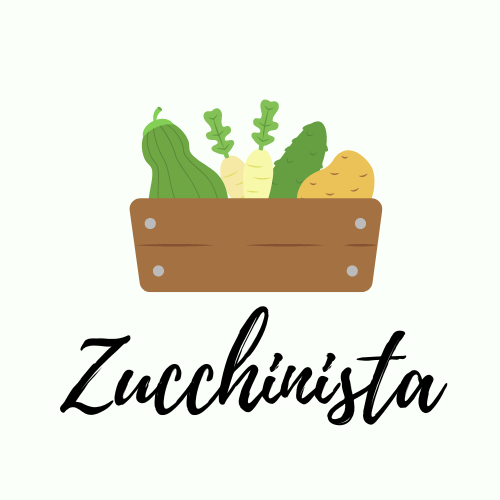These Honey Cookies are a honey-sweet and spicy treat that tastes good all year round. Because the dough does not contain eggs, they are crispy not only around the edges, but deliciously crunchy and crispy through and through.
One thing I really miss since living gluten-free is brown cakes. Here in Hamburg, there is a local speciality called “Kemm’sche Kuchen”, a kind of gingerbread or brown cookies made with spices and syrup. Unlike other gingerbread, these are available all year round, even though the Christmas season is when people eat the most of them. This product goes back to a recipe from 1782, so you can really talk about a long tradition. Generations of Hamburgers have grown up eating a bun spread with butter and topped with a brown cake as their Sunday breakfast.
Of course, these honey biscuits can’t bring me back the factory-made original. However, they are not supposed to be a substitute for it, they are simply too distinct with their fine honey note and the crunchy chopped nuts. However, what they do have in common with the brown cakes of my childhood is that they still taste good long after Christmas. Because their taste is only slightly rounded off with the typical gingerbread spices and the honey note is particularly concise, I think you can enjoy them all year round.
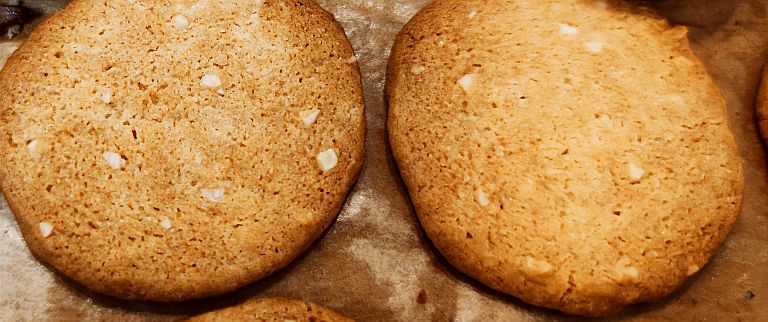
Ingredients and substitutions
Butter
A special feature of this recipe is that the butter is melted at the beginning of the preparation, together with the sugar and honey. The reason for this is to dissolve the sugar crystals in the liquid ingredients. This results in biscuits that are particularly even in colour and browning and have a regular, fine consistency. If there are still coarse sugar crystals in the biscuit dough, they will brown particularly strongly during the baking process and this results in a blotchy, speckled appearance of the finished biscuits. While coarse sugar pieces in biscuit dough certainly also bring a desired sensory effect, just think of the crunchy sugar coating of Snickerdoodle biscuits, this effect should rather be avoided in the Honey Cookies recipe.
Since the butter is melted in this recipe anyway, this is now one of the few biscuit recipes where it doesn’t matter whether you use room-warm or refrigerator-cold butter.
Since butter is a dairy product that I tolerate well, I like to incorporate it into my diet and use it as a source of saturated fat.
As a substitute for butter in this recipe, I would recommend a fat that is solid at room temperature. So liquid oils like olive oil are not ideal to use here. Coconut fat works well, though I find that pastries and especially biscuits always turn out a little crumblier and crumblier with coconut fat than they would with butter.
The recipe would also be good with pure butterfat, i.e. ghee or clarified butter. Traditional recipes for honey biscuits or brown cakes even often use beef tallow or lard.
Coconut blossom sugar
Coconut blossom sugar is a relatively natural type of sugar and brings not only a subtle caramel note, but also a beautiful golden brown hue to this biscuit recipe.
If you want to bring out the honey note more strongly and unadulterated, you can also use white sugar with its clear, neutral sweet taste instead of coconut blossom sugar. Because of the eponymous honey and the starchy ingredients that make up a large part of the recipe, it will hardly be possible to convert this into a low carb version. But one way to save carbohydrates, or even just sugar, is to replace the coconut blossom sugar with another granulated sweetener. You could use erythritol, which has 0 calories and about 60% of the sweetening power of sugar, or xylitol, which is about as sweet as sugar and contains 2.4 kcal per gram. Mixtures of these sugar substitutes are also available on the market and are said to be particularly suitable for baking. Both xylitol and erythritol have much less effect on blood sugar and insulin levels than sucrose.
There are two different types of sweetening components in this recipe, honey being a liquid sweetener and sugar or coconut blossom sugar being a crystalline sweetener. The combination of these two different consistencies has many advantages so I would recommend to stick with this combination.
If you were to use only honey, the consistency would quickly become runny. The proportions of gluten-free flour and starch are such that a smooth dough will result if only a partial amount of honey is used. So if you were to use only honey instead of the crystalline sweetener, you likely would have to add a greater amount of flour.
Honey
It is amazing how much honey can differ in taste and consistency – only because of what kind of flowers are available to the bees at the moment. I have used a clover honey here that is medium-firm in consistency – thick and creamy. In terms of taste and consistency, it is most reminiscent of sunflower honey. However, you can just as easily use any other honey or a mixed honey. Since the honey is melted with other ingredients, you can also use viscous semi-solid honeys such as rapeseed honey. Particularly aromatic honeys such as acacia honey will possibly have a stronger effect on the taste of the finished cookies.
Since honey is the recipe’s namesake ingredient, substituting it would result in a significantly different outcome. Of course, you could use maple syrup, agave syrup or, as the most flavourful alternative, sugar beet syrup, especially if you are trying to make a vegan adaptation of the recipe. But the taste would be quite different and you definately would not be able to name them Honey Cookies anymore 😀
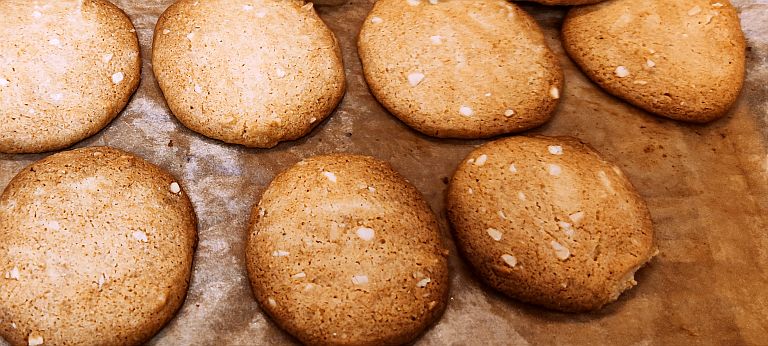
Gluten free flour mix
I have used the gluten-free flour mix for cakes and biscuits from Schär. I actually achieved good results with it in all baking recipes, so I would also recommend this as a universal mix. The good thing is also that you can use this 1 to 1 in all recipes that are tailored to all-purpose flour. If you want to keep the recipe according to a paleo diet or if you simply don’t have a gluten-free flour mix to hand, you can substitute it with ground blanched almonds and starch, each measured to half the amount of the flour used. To be honest, the advantage of ready-made flour mixes is that they usually contain thickening agents such as carob bean gum. They ensure that the doughs have a better consistency and workability, are more elastic and do not crack as quickly.
If you are not sensitive to gluten, you can also use all-purpose flour or type 405 wheat flour. However, I would always recommend spelt flour for the preparation of biscuits, as it has a low gluten content and the biscuits become particularly crumbly and crunchy.
Ground blanched almonds
I use ground almonds here to achieve a looser, finer crumb. The original recipes for brown cakes or honey cakes, on the other hand, use only flour and no ground nuts. This makes the dough more compact and the finished biscuits firmer and harder. Basically, I prefer to use flour made from blanched almonds, i.e. almonds that have been separated from their brown skin before being ground, for baking pastries and biscuits. This makes the pastry particularly even and tender. In addition, the skin tends to bring bitter and stale notes. But if this doesn’t bother you, you can also use ground, unblanched almonds. To me, the slightly milky and sweet flavour of the almonds is the perfect companion for the honey, but you can substitute it with other ground nuts such as hazelnuts, walnuts or cashews.
Potato starch
Potato starch is my go-to solution for all tasks in the kitchen that require starch. While many Paleo recipes call for arrowroot starch or tapioca starch, these types of starch come from exotic plants that have to be imported over long distances and are probably disproportionately expensive for more than just that reason. Potato starch, on the other hand, is cheap and regional. It is also allergen-free and grain-free and serves the same purpose in terms of kitchen technology. Yes, even if there were no nutritional reasons against using maize starch or wheat starch, I would always prefer potato starch for technical reasons alone. It produces a light and transparent binding in sauces and a particularly fine, crumbly texture in pastries.
Gingerbread spice
Commercially available gingerbread spice mixtures vary quite a lot in their composition, depending on the brand. Spices such as coriander, cinnamon, nutmeg, allspice, ginger, mace, star anise, cardamom, fennel, cloves, but also dried lemon and orange peel can be used. I have used a mix here that contains coriander, cinnamon, nutmeg, allspice and ginger.
With their warm, spicy and slightly floral aromas, the spice blends lift and harmonise the inherent flavour of the honey cookies. Therefore, not too much of the spice mix should be used, so that honey and almonds always remain in the fore. If you want to put together your own spice mix, make sure to use ground cloves only very sparingly or perhaps leave them out altogether, as they quickly taste obtrusively dominant.
Basically, Gingerbread Spice corresponds to the Pumpkin Pie Spice spice blends, which are more common in the Anglo-Saxon-speaking world.
There are also various versions of Pumpkin Pie Spice, but most of the recipes available online can be summarised as a mixture of four parts cinnamon and one part each of nutmeg, ginger, allspice, cloves and cardamom.
If you don’t have a ready-made spice mix at hand, I recommend using half a teaspoon of cinnamon and a pinch each of coriander, nutmeg and allspice for seasoning. If you just want to enhance the flavour of the honey and almonds, you can also just use a little vanilla extract to flavour the biscuits.
Chopped blanched almonds
The chopped almonds lighten up the honey cookies both visually and in the bite and give them that extra nutty crunch. Traditionally, chopped candied orange peel and candied lemon peel are also added, just as the grated lemon or orange peel is used for flavouring. But since the peel of citrus fruits is rarely to my taste and, in my opinion, should be used sparingly, I have dispensed with these ingredients altogether and added only the chopped almonds as a chunky ingredient.
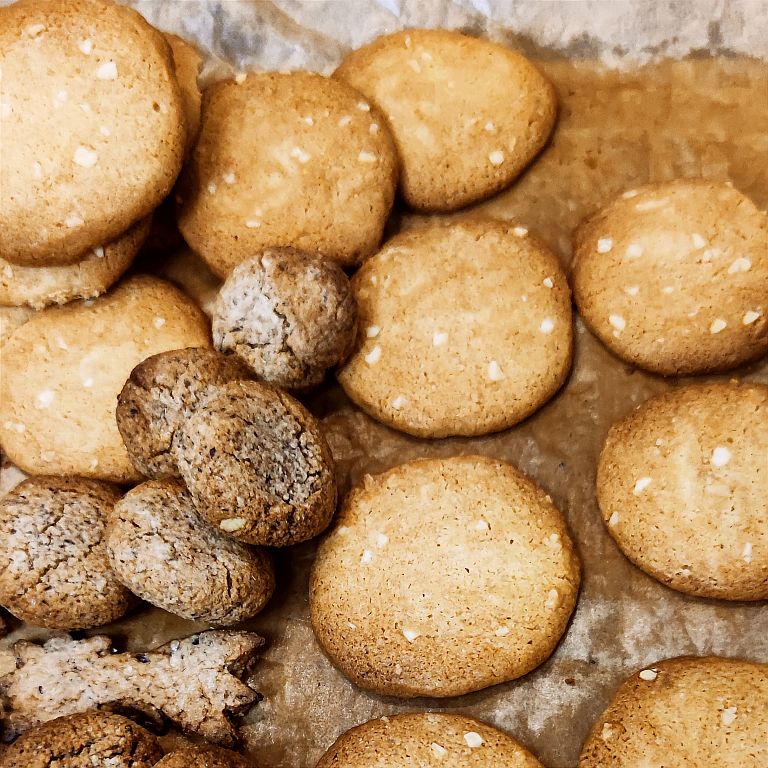
How to prepare the honey cookies
The dough has a resting time, but this also makes it easy to prepare and flexible to bake. The actual working time is much shorter. Precisely because the dough is formed into a roll from which the biscuits are cut into slices, i.e. the individual cookies do not have to be formed by hand, the Honey Cookies are very rational to make.
The dough will keep in its raw state in the fridge for at least several days. Because it does not contain raw eggs, it cannot spoil quickly. So you can prepare them in advance and bake them when you have time, or when the ideal time for oven-fresh cookies has come. The fact that they still run a little in the oven means they are always in good shape and flat, crispy cookies are ready with minimal effort.
To be even more flexible, you can also freeze the dough. There are two options here, either you freeze the lump of dough whole, in which case you have to let it defrost completely before you process it further. Or you can freeze the unbaked dough already portioned into slices. Then you can arrange the dough slices while still frozen on a baking tray lined with baking paper and put them in the oven while still frozen. Of course, the cooking time should be adjusted here, but again, slightly browned edges of the cookies are a good indicator that they are done baking.
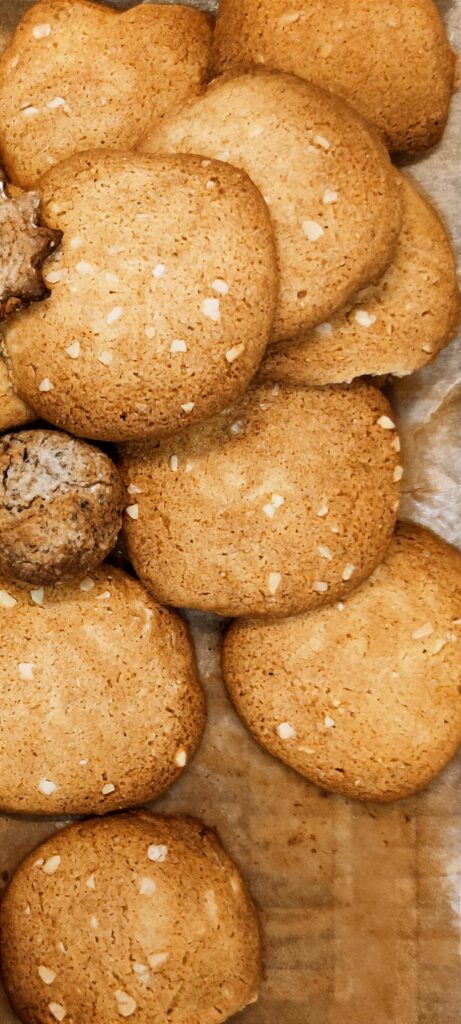
Best ways to enjoy the honey cookies
These honey cookies always look good anywhere, from a mixed plate of cookies and gingerbread in the run-up to Christmas to a sweet breakfast biscuit or a little extra dessert for the lunchbox.
They would go particularely well with a hot milk drink of your choice, be it a pumpkin spice latte or a hot chocolate and depending on your individual dietary habits and taste with a base based on cow’s milk or on different types of nut milks.
Best ways to store
After cooling, it is best to store the honey cookies in an airtight container such as a classic tin biscuit tin. This way they retain their crispy crunchiness.
If the Honey Cookies are stored open, they soften quite quickly, but they are still delicious and have a crumbly pleasant texture. Either way, the Honey Cookies basically have an unlimited shelf life. But this is only a theoretical value. I’m sure you’ll need to replenish them quickly, as the Honey Cookies will be eaten in no time 🙂
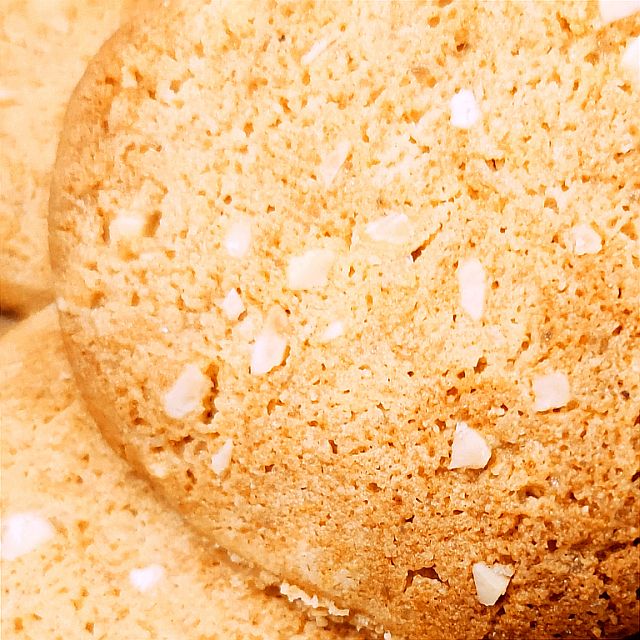
Honey Cookies
Description
These thin and crispy Honey Cookies are satisfyingly tender and nutty while honey-sweet and subtly spicy.
Ingredients
Instructions
-
Melt the butter, brown sugar, and honey in a small saucepan over low heat until the sugar crystals have dissolved. Stir thoroughly while the ingredients are melting and use the lowest setting on the stovetop. Let the mixture cool down.
-
Sift over the gluten-free flour and potato starch, then add the ground almonds, spices, salt and baking powder. Knead all the ingredients together with your hands or the dough hook of the hand mixer to form a smooth dough.
-
Add the chopped blanched almonds lastly and knead until they are evenly distributed.
-
The dough is initially still a bit soft and malleable, but not flowable. If it's too soft, add a little more gluten-free flour or starch to get the consistency you want.
-
Shape the soft dough into a roll with a diameter of about 4 cm.
-
To prevent the cookies from losing their shape during baking, the dough has to rest in the refridgerator. The dough should rest for at least 6 hours. But you can easily store the dough overnight or even longer.
-
Now the dough should have a firm consistency. Cut slices of 5 mm thickness from the dough roll and arrange them a few centimetres apart on a baking tray. This amount of dough usually makes 2 baking trays full of cookies.
-
Bake the cookies at 180°C with fan on the middle shelf of the oven until the edges of the cookies start to brown slightly. This should take about 10-12 minutes.
-
Carefully transfer the baking paper with the cookies onto a wire rack or wooden board. The cookies will still be very soft when they come out of the oven, but they will cool completely and be crispy in 10-15 minutes.
-
Store the cookies in an airtight container to preserve their crispiness.
